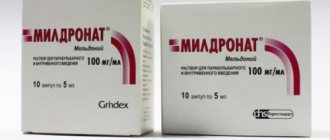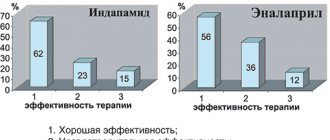What are hemorrhoids and why does pain occur?
Hemorrhoids are a disease that occurs as a result of stretching and deformation of blood vessels in the rectum and anus. This occurs under the influence of many factors, but the main ones are considered to be an increase in intravascular pressure in the pelvic organs and the development of stagnant processes. Veins and capillaries become overfilled with blood, their walls lose tone and elasticity, resulting in the formation of vascular nodes that cause unbearable pain to a person. At the onset of the disease, discomfort rarely occurs; pain develops mainly during bowel movements and during severe physical exertion. With the further development of the pathology, the symptoms worsen; it hurts the person to walk, sit, or perform bowel movements.
Pain syndrome occurs due to irritation of the nerve endings located in the rectal area. They are responsible for the normal contraction of muscle fibers, which allows for the act of bowel movement.
Many experts believe that you can get rid of pain from hemorrhoids by choosing the right sitting position, chair, and also taking into account some other aspects of workplace organization.
What are the symptoms of driver's hemorrhoids?
If a driver is suspected of having hemorrhoids, his symptoms, in fact, will not differ much from the classical course. The main complaints among men are painful itching in the anus and perineum, which is formed as a result of the leakage of mucus and irritation of the skin. Hemorrhoids also cause painful symptoms - they are localized inside the rectum or in the anus; a pulling and pressing sensation may occur inside the perineum, especially intensifying after a working day. If this is an exacerbation of hemorrhoids, the symptoms are supplemented by general malaise, bleeding, fever and even thrombosis. However, the difference between driver’s hemorrhoids is the fact that all manifestations can be more pronounced than in other men. This is largely due to the fact that even in the presence of primary symptoms of hemorrhoids and malaise, they are forced to work and lead their usual lifestyle (completely unsuitable for hemorrhoids), which aggravates the manifestations of the disease.
This includes dry food, which is almost always formed on long trips, and where there is no access to healthy dietary food. This is sitting for a long time when you need to move. The driver needs to steer, he needs to carry out the plan, and this means sitting behind the wheel for many hours. Of course, you should under no circumstances ignore the first warning signs; this can only worsen your condition and completely deprive yourself of your ability to work due to complications. Sometimes drivers get their hemorrhoids so bad that the only treatment option for them is surgery and a long period of rehabilitation.
How does sitting position affect the disease?
While sitting, the pressure in the abdominal cavity increases, including in the rectal area. As a result, the outflow of blood is disrupted, veins and vessels become overfilled with blood, pain, swelling and other manifestations of pathology develop. Despite this, it cannot be assumed that hemorrhoids develop under the influence of only this provoking factor. Often the pathology occurs in people engaged in heavy physical work, in patients with excess body weight. A major role is played by the hereditary factor, various diseases accompanied by weakness of the vascular walls.
When is surgery needed? Do I need to remove hemorrhoids?
There are several stages of development of the disease:
With the first there are no pronounced symptoms. As a rule, they appear only in certain situations. The patient may experience itching, burning and discomfort during bowel movements. Treatment at this stage allows you to quickly get rid of the problem.
At the second stage, there is a significant increase in the size of the nodes. Due to the thinning of the walls of the nodes during defecation, hypothermia, overheating or physical exertion, traces of blood appear on toilet paper or underwear. There is a possibility of the nodes falling out during defecation, but they are able to move into place on their own. Conservative treatment at this stage is also effective. Modern medicine has effective methods to combat the manifestations of hemorrhoids.
The third stage is characterized by dystrophic changes in the anal sphincter. As a result, dropped nodes can be put back in only manually. Conservative treatment at this stage is no longer effective. The patient experiences severe itching, pain, and bleeding becomes more profuse.
At the fourth stage, repositioning the nodes inward is almost impossible due to weakening of the anal muscles. Not only the nodes, but also nearby tissues can become inflamed.
Medicine today successfully treats the first two stages of the disease. If the problem reaches the third or fourth stage, then surgical intervention and removal of nodes will no longer be possible. Therefore, it is extremely important to immediately contact a proctologist at the first symptoms.
General recommendations
If sitting with hemorrhoids hurts, but work requires it, you can reduce the pressure on the rectum and tailbone area by following simple rules. These include:
- It is important to choose the right height of the chair on which a person spends a long time. The legs should be bent at an angle of 90 degrees, which allows you to transfer part of the load to the feet;
- It is desirable that the chair has a back and armrests. Relying on them, a person relieves pressure on the anorectal area;
- If you have hemorrhoids, you should sit for no more than 2 hours. During breaks between work, be sure to get up, do warm-ups or special gymnastics;
- It is better to sit on a surface with medium hardness; a seat that is too soft can cause even more prolapse of cavernous formations outward.
A chair for a person with hemorrhoids must meet all quality standards and be made of natural materials
Along with this, the person must be prescribed the correct drug therapy. Dimexide has a good effect on hemorrhoids and other painkillers and anti-inflammatory drugs.
Important! In addition to posture and choice of chair, for hemorrhoids it is recommended to use special orthopedic pillows; sometimes the use of cool heating pads is allowed.
The main causes of pain in the anus can be:
- Oncological disease,
- Anal fissure (small tear in the lining of the anus),
- Anal itching,
- Anal sex,
- Anorectal fistula (an abnormal passage between the anus or rectum, usually leading to the skin near the anus),
- Coccydynia or coccydynia (pain in the tailbone),
- Constipation,
- Crohn's disease (inflammatory bowel disease),
- Diarrhea causing anal irritation
- Fecal impact (a mass of hardened stool in the rectum caused by chronic constipation),
- Hemorrhoids (swollen and inflamed veins and venous nodes located in the anus or rectum),
- Levator anus syndrome (spasm in the muscles surrounding the anus)
- Perianal abscess (pus in the deep tissues around the anus),
- Perianal hematoma (collection of blood in the perianal tissue caused by a ruptured vein, sometimes called external hemorrhoids),
- Proctalgia fugax is a transient, transient proctalgia (an attack of sharp pain that suddenly occurs in the rectum, which can last for several minutes or hours,
- Proctitis (inflammation of the rectal mucosa),
- Solitary rectal ulcer syndrome (rectal ulcer),
- Thrombosis of hemorrhoidal node,
- Injury,
- Ulcerative colitis,
- Ulcerative proctitis (inflammatory bowel disease).
You should seek medical help immediately if:
- there is intense rectal bleeding that cannot be stopped, especially if it is accompanied by dizziness or a feeling of general weakness;
- anal pain progresses, spreads to other areas or is accompanied by anal discharge, as well as fever or chills;
A scheduled visit to the doctor is necessary if:
- the pain lasts for several days and painkillers do not help;
- if pain is accompanied by changes in bowel function or bleeding.
With hemorrhoids that develop quickly or are particularly painful, a blood clot (thrombus) may form inside the venous node. A hemorrhoidal clot, although painful, cannot break loose and travel through the bloodstream, so it will not cause serious complications such as stroke, pulmonary embolism, or coronary embolism—commonly associated with blood clots that have formed in other parts of the body.
Be sure to see your doctor for advice about rectal bleeding if you are over 40 years of age. Goal: to rule out a serious disease such as colon cancer.
Read more about sitting posture
Most patients find it painful to sit with varicose veins in the rectum and anus. You can partially eliminate the discomfort with the correct posture on the chair. To do this, you must adhere to the following recommendations:
- A straight posture will help get rid of pain. Keeping your back straight for a long period is quite difficult if you have not done this before, but this will help take the pressure off your coccyx and rectum. Over time, the back muscles will become stronger, maintaining posture will become a habit, which will become useful not only for combating soreness, but also for the overall health of the back;
- The height of the chair should allow your feet to rest completely on the floor, while your knees should be at an angle of 90 degrees;
- Heated seats cannot be used. High temperature causes a rush of blood to the affected area, which will cause increased pain and swelling. In case of exacerbation, it is better to use a cool compress;
- The patient's posture should consist of right angles.
While sitting, it is important to maintain an even posture, with your feet touching the floor
Patients with hemorrhoids are advised to get up from their desk as often as possible. Sitting for a long time causes blood to stagnate, blood vessels to stretch, and there is a risk of blood clot formation. To prevent complications and severe pain, you should warm up every 40–60 minutes. Gymnastics can be performed at home, in the office or anywhere else.
Timely diagnosis
To avoid hemorrhoids and possible complications, it is necessary to identify the disease at its earliest stages. Internal hemorrhoids can be detected by digital examination of the rectum, feeling for compaction of the hemorrhoidal veins. But such an examination is effective only when the nodes are located low. If the cones are located high up, then only modern equipment can help in diagnosing the disease. Anoscopy and sigmoidoscopy are the most common techniques. In the first case, a special tube with an optical device is used, which allows one to examine the rectal mucosa over a ten-centimeter length. If the hemorrhoids are located even higher, then you cannot do without the help of a sigmoidoscope. The rectum at a distance of 25 cm will be “in full view” to the doctor. If the patient states that during defecation he himself observed the prolapse of nodes, then a diagnosis can be made based on this reliable fact. True, unfortunately, for the patient the stage of the disease in this case is later, and therefore less treatable.
Choosing a chair
What to sit on if you have hemorrhoids? If it is painful for a person to sit due to varicose veins in the rectal area, special attention should be paid to which chair to sit on. A desk chair must meet several criteria:
- the presence of a high straight back without bends;
- comfortable and soft armrests;
- the depth of the seat should correspond to the length of the thigh, and the height to the length of the lower leg;
- the seat should be semi-rigid, the upholstery should be made of natural fabric, the filling should be foam rubber or polyurethane;
- The legs of the chair are stable, the product should not wobble.
If you have hemorrhoids, it hurts to sit even on a comfortable chair in the right position; doctors recommend using special pillows.
Which doctor should I see for hemorrhoids?
When the first symptoms occur or an exacerbation of an existing disease occurs, it is important to immediately make an appointment with a proctologist. An experienced specialist will help eliminate pain and create an effective treatment regimen. It is important to follow the instructions, as well as normalize your diet to ensure regular bowel movements and the absence of constipation. Experienced specialists will be able to effectively help every patient. The main thing is not to delay your visit to the doctor.
1
0
1
Article rating:
4 out of 5 based on 9 ratings
Author: Kutepova Ekaterina Vladimirovna
Surgeon-proctologist. Candidate of Medical Sciences. Highest category. Work experience 15 years.
Using an orthopedic pillow against hemorrhoids
For patients forced to lead a sedentary lifestyle, doctors advise using special devices in the form of pillows to relieve stress on the rectal area. Pillows can be round, square, rectangular, they can have different fillings, heights and sizes, but their meaning is that each product has a special hole or recess located directly in the area of the coccyx and anus. The products can be used not only during illness, but also for people at risk of hemorrhoids.
It is better to entrust the choice of a pillow against hemorrhoids to your doctor
Criteria for choosing an orthopedic product:
- Depending on the filler, there are inflatable, foam and polyurethane pillows. When choosing a device, the patient's weight should be taken into account. For people with excess body weight, it is better to avoid inflatable and foam rubber products; products based on elastic polyurethane are suitable for them;
- the fabric of the product should be natural, allow air to pass through well, and not create a greenhouse effect, because overheating of the anorectal area has a detrimental effect on the progression of hemorrhoids;
- It is better to choose products from well-known manufacturers that are popular in the modern market and have positive patient reviews. The product must have a quality certificate.
Important! Even when using an orthopedic product, we must not forget that it is periodically necessary to get up from your workplace.
Phlebaven® for hemorrhoids
The flavonoids hesperidin and diosmin, obtained from plants, have shown good results in the non-surgical treatment of hemorrhoids. They increase the tone of the veins, improve microcirculation, and prevent exacerbation of the disease.4
According to the instructions, the drug Flebaven® is used in the treatment of acute hemorrhoids. The dosage and need for use in a particular patient is determined by the attending physician.5
References 1. Karpukhin O.Yu., Modern methods of treating hemorrhoids, Practical Medicine, 2003. 2. Rivkin V.L., Outpatient treatment of hemorrhoids, Hospital-replacing technologies: outpatient surgery, 2014. 3. Association of General Practitioners of the Russian Federation, Clinical guidelines for general practitioners (family doctors): hemorrhoids, 2014. 4. K.E. Mayat, Modern methods of treating hemorrhoids, Attending physician, No. 3, 2008. 5. Instructions for the drug Flebaven®.
Created by experts commissioned by KRKA PHARMA LLC
Tips for drivers
Hemorrhoids are a common occurrence among drivers who are forced to spend long periods of time behind the wheel. Many representatives of this profession suffer from constant pain and exacerbations of pathology. To alleviate the condition, drivers should know how to sit behind the steering wheel of a car correctly. There are many devices available to help reduce discomfort during hemorrhoids.
Let's look at a few of them:
- orthopedic pillows for hemorrhoids. These products are often placed on the car seat. Many of them are equipped with special fixing straps, which ensures ease of use. The pillows are filled with polyurethane and foam rubber. It is not recommended to use inflatable devices in cars;
- special massage mats. The devices are made of high-strength natural material, wood, bone, and help stimulate blood circulation and restore lymphatic drainage. Contraindications include acute disease, surgery, open wounds;
- pillows with natural fillings. Products filled with buckwheat husks, flaxseed and other products have a good effect. They help to perform a gentle massage, prevent stagnation and the formation of blood clots.
Special massage mats help increase blood circulation
When choosing a device, you should consult with a specialist and strictly follow his recommendations. During long flights, you can stop, walk near the car, and do a light workout, if the situation allows it.
Balanced diet
Diets, colon cleanses and enemas are the main provocateurs of anal problems. But a diet balanced in carbohydrates, proteins and fiber, and adherence to a drinking regime will improve regular bowel movements and relieve constipation.
Consume fermented milk products, which improves intestinal microflora. Eat fruits, vegetables, cereals and bran bread - all these foods improve intestinal motility.
Avoid alcohol and spicy foods. Reduce your consumption of flour, especially baked goods.
How to sit after node removal surgery
Hemorrhoids often require surgical intervention. After surgery, patients have a question: how and when can they sit after removal of cones? Only a doctor can answer here, because everything depends on the type of intervention and the individual characteristics of the body. After using minimally invasive techniques, sitting on a soft or hard chair is not recommended for the first 24 hours.
The patient needs to lie down or stand. After an open or closed hemorrhoidectomy or hemorrhoidopexy, you should not sit for the first week. With the permission of the attending physician, you can spend a small amount of time in a sitting position. It is better if it is a bed or chair with medium hardness.
How to properly equip your workplace
- Position the orthopedic chair, table and computer correctly. Pay special attention to the height of the table - it is set according to the individual characteristics of the person.
- Correctly position the computer mouse and keyboard to avoid carpal tunnel syndrome. This can cause numbness in the fingers, reduce sensitivity in the hand, and pinch the nerve in the wrist.
- Arrange for sufficient lighting.
As you can see, everything is simple and accessible! You need to sit on a chair correctly, comfortably and in pleasant conditions! Only with this approach will you prevent spinal diseases and keep your back healthy and beautiful! Good luck!
Gymnastics between sitting
Every person leading a sedentary lifestyle, regardless of the presence of hemorrhoids, should get up from their desk every 1.5–2 hours and do a basic warm-up or therapeutic exercises. Physical education helps disperse blood throughout the body, reduce the risk of developing stagnant processes, and prevent possible complications. Charging can be done both at home and at home.
A set of exercises for office workers:
- quickly squeeze and unclench your buttocks. This can be done in a sitting or standing position. At a time it is necessary to perform at least 10 contractions in 3 approaches;
- Ordinary walking will help disperse blood throughout the body; you can walk several flights of steps;
- standing, feet shoulder-width apart, lift your left leg, bent at the knee, lower it, then the right. Do 20 repetitions for each leg;
- make several strains as during bowel movements or during childbirth.
This simple warm-up will help significantly improve the condition of the veins in the rectum and anus.
Regular exercise helps prevent complications of hemorrhoids and reduce pain
Gymnastics to perform at home:
- scissors - performed while lying on your back. It is necessary to raise your legs at an angle of 45 degrees, alternately cross your straight limbs, imitating clipping scissors;
- birch - performed in the same position, legs straight, lift the pelvis off the floor as much as possible, leaning on bent elbows, fixate for 5-10 seconds, return to the starting position;
- walking on the buttocks - sitting on the floor, lift your left buttock off the floor, rearrange it, then the right. You will get movement on the buttocks. This exercise perfectly accelerates the blood in the pelvic organs;
- walking with high knees will help accelerate the metabolic processes of the whole body;
- back arches - bend your lower back up, then down, standing on all fours, repeat the exercise 5-10 times.
Important! During an exacerbation, it is better to refuse physical exercise, as this can negatively affect the course of hemorrhoids, cause severe pain and other complications.
Conclusion
I would like to draw a conclusion from all of the above - you should not delay going to the doctor if you notice at least one of the signs of internal hemorrhoids:
- itching;
- burning;
- pain during bowel movements;
- appearance of blood in the stool;
- mucous, odorous discharge;
- prolapse of hemorrhoidal cones.
If you find such signs in yourself, do not panic, but pull yourself together and find a good proctologist. Hemorrhoids can be treated successfully if all medical instructions are followed. You should not discount traditional methods (as an addition to the main treatment) or lifestyle changes. Start eating right, sign up for a fitness center, give up bad habits - success will definitely be on your side!
Kegel exercise on a chair
Alfred Kegel is a famous American gynecologist who developed an exercise that was originally intended to restore the uterus after childbirth, prevent urinary incontinence and prolapse of internal organs. Later it turned out that this exercise has a positive effect on all pelvic organs. For hemorrhoids, Kegel exercises can be done while sitting in a chair or standing. To do this, a person needs to learn to contract and relax internal muscles. The mechanism of execution resembles an attempt to hold back urination. The muscles need to be squeezed, stay in this position for a few seconds, then relax. To begin with, you should perform 5–7 repetitions, gradually increasing the load.
Workouts at home and at work
To warm up your muscles for a short time, you don’t need to get up and go somewhere. It is enough to start by relaxing and squeezing the muscles of the anus - 10-15 minutes each. Do 30 exercises in one approach, then their number is increased up to a hundred times.
Light exercise not only activates blood circulation, but helps to distract and relieve emotional stress. In the office, you can use a stripped-down Kegel technique aimed at preventing weakening of the pelvic muscular system. Using the complex:
- blood circulation improves;
- the muscles responsible for supporting the rectum are activated.
The point of the exercise is to squeeze the gluteal muscles, simulating an attempt to rise above the chair. Having reached maximum tension, spend 3 seconds in this state, then relax. The number of repetitions is up to 15 times, 50 approaches are performed per day.
Spending a long time at the monitor requires blood to flow out of the pelvic area. Simple but effective measures to solve the problem include:
- evening walks - several stops on foot along with a bus ride;
- long visit to the park on a weekend;
- daily morning exercises and light training in the evening (with scissors, bicycle, etc.).
During your vacation, you need to walk more, climb stairs (ignore the elevator), and swim in the pool. Weight control is no less important - every extra kilogram creates additional stress on the blood vessels, increasing the risk of reducing their functionality and the subsequent development of various diseases.
Possible consequences of the disease in women
As mentioned above, untimely and incorrect treatment can lead to the development of complications that are much more difficult to eliminate. Possible consequences of hemorrhoids in women include:
- Polyps that can form in the colon. Moreover, they will not make themselves felt, and they can only be detected during a routine inspection
- Cancer, since during hemorrhoids the structure of the mucous membrane and cells changes, the body is forced to fight infection, and this can be very stressful
- Colitis, the main symptoms of which are diarrhea and abdominal pain. It is colitis that develops parallel to hemorrhoids, and it is not always possible to recognize it at the very initial stage
- Constipation. This is one of the causes of hemorrhoids, and also its consequences. When hemorrhoids swell, the process of defecation becomes difficult, and it is more difficult for stool to pass through the intestines
- Cracks, which are an excellent place for bacteria to multiply and, as a result, penetrate into the body
- Cryptit. Because of this disease, the risk of developing malignant tumors increases many times.
As for pregnant women, they suffer the most. Not only is your health not good enough to lead an active lifestyle. But when pain and problems with bowel movements are added to this, it upsets many. In addition, untreated hemorrhoids significantly prolong the postpartum period, since in addition to ruptures that occurred during childbirth, there are other problems.
How to choose furniture for relaxation
At the end of the working day, many are warmed by the thought of their own sofa: “When I go to bed...” Lie down, relax, but don’t sit down! A cozy soft chair in which you can climb with your feet, a huge soft sofa is to the liking of the hemorrhoid enemy - in them all the blood tends to the “fifth point”. It is also prohibited to rest on other types of furniture:
- stools without backrest;
- excessively low sofas and armchairs;
- chairs with soft seats bounded by a metal rim;
- slippery plastic chairs.
By trying to hold on to such furniture, you unwittingly concentrate your weight on the pelvic area, which means you are helping the disease. The features of the optimal lounge chair are presented in the table.
| Size | Average |
| Softness | Average |
| Depth | Shallow |
| Height | Suitable for height |
| Back | Inclined, smooth |
| Armrests | Wide, soft |
| Upholstery | Fabric |
| Filler | Polyurethane |
| Legs (if any) | Heavy, stable |
The danger of hemorrhoids in women
Hemorrhoids in a woman
Many people believe that hemorrhoids are not a dangerous disease, since it practically does not affect the internal organs. And therefore, treatment is started only when it is no longer possible to endure. This is one of the most dangerous misconceptions, since hemorrhoids can negatively affect a woman’s health. If treatment is not started in time, node thrombosis or paraproctitis may develop.
Thrombosis of nodes occurs after frequent pushing and after prolapse of swollen hemorrhoids. Because of this, blood clots may occur in other places. And, as you know, blood clots themselves are very dangerous, since they can break off at any moment and provoke a heart attack and blockage of blood vessels. Thrombosis of the nodes is manifested by sharp pain during bowel movements, constipation, swelling of the nodes, an unpleasant odor, as well as specific discharge. Hemorrhoids, if blood clots have formed in them, take on an irregular shape and are covered with a white coating.
In severe stages of thrombosis, severe bleeding is possible, which should promptly consult a doctor.
We need to talk separately about paraproctitis. This is an inflammation of the skin around the anus, and it begins to fester. It also appears due to the occurrence of microcracks and abrasions, especially when no antibacterial agents were used to eliminate the infection. Because of this, it penetrates inside and the process of suppuration begins. And if treatment is not started in time, the destructive process will affect the intestinal walls. And it will gradually move on to the woman’s reproductive organs. Therefore, hemorrhoids should be treated immediately to avoid negative consequences and the use of expensive medications.









